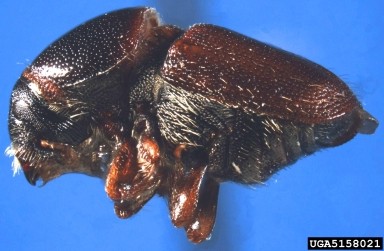Pests
Scolytus mali (Bechst.) - Apple Bark Beetle, Larger Shothole Borer.
Systematic position.
Class Insecta, order Coleoptera, family Scolytidae, genus Scolytus Geoffr.Synonyms.
Scolytus bicallosus Egg.; S. nitidulus Chap.; S. rimskii Kur.; S. sulcatus LeConte; S. dahuricus Mannh; Eccoptogaster mali; E. castaneus Ratz.; E. pruni Ratz.; E. pyri Ratz.Biological group.
Pests of pear, apple, and stone-fruit trees.Morphology and biology.
Adults are shining reddish-brown. Body length is 2.5-4.5 mm. Male frons flattened; female frons convex without middle carina. Disk of pronotum smooth with shallow, somewhat erased punctuation. Punctures on each side of pronotum are denser but not touching each other. Scutellum is triangular and mat. Elytra are narrowed toward broadly rounded apex and somewhat indented along margin in preapical part. Elytral striae are shallow and slightly irregular. Elytral interstriae are broad and flattened, with row of punctures having distinctly smaller diameter than that of punctures in striae. Abdomen is straightly sloped distad; its surface is covered with sparse short erect hairs being longer on sides. Apical angles of 3rd-4th ventrites are not elevated; 5th ventrite has middle apical emargination which is bordered with long hairs.Distribution.
Inhabits most part of Europe. In the former USSR, it is widely distributed in the European part northward to Leningrad Region and Baltic States, in the Caucasus, in the South of Siberia eastward to Transbaikalia, in Middle Asia and probably Kazakhstan.Ecology.
Monovoltine. Hawthorn, mountain ash, cornel, elm are the natural host plants of S. mali. It hibernates in the stage of larva. Pupation occurs in May. Adults fly from the beginning of June to mid-July. S. mali is a common species in southern regions; occurring more often in orchards than in the forest. It predominates by abundance among bark beetles in the Eastern Caucasus. The pest attacks trunks and thick branches of depressed, rarely healthy trees. Female gnaws longitudinal mother gallery under the bark; their length is about 5-6 cm (rarely to 12 cm), and width is 2 mm. Mother gallery has enlargement near hole where mating of adults occurs. The female gnaws out small cavities for eggs in the sides of mother gallery. Fertility is about 50-100 eggs. Larval galleries are straight and situated on each side of mother gallery between the bast and alburnum layers of tree. Long larval galleries change their orientation slightly. Larvae of Raphidia major Burm. (Raphidioptera, Raphidiidae), Clerus mutillarius F. (Coleoptera, Cleridae), Nemosoma caucasicum Men. (Coleoptera, Trogossitidae), Medetera collarti Negrob. (Diptera, Dolichopodidae) and adult Aulonium trisulcum Geoffr. (Coleoptera, Colydiidae) are the predators of S. mali.Economic significance.
The pest damages mainly in abandoned old orchards in the steppe zone of Ukraine and Caucasus. Perhaps adults are the vectors of Ceratocystis ulmi (Buism.) which cause the Dutch elm disease. Control measures include using fertilizations, pruning and burning of trees and branches infested by S. mali; the use of trap trees and trap branches for adults. Pesticide treatment is necessary at the pest high abundance during flight of adults.Reference citations:
Alonso-Zarazaga M. A. Fauna Europaea. 2007. http://www.faunaeur.org/index.php.Chugunin Ya.V. 1935. Control of orchard pests. Moscow & Leningrad: OGIZ, 160 p. (in Russian).
Gussakovskii V.V. 1949. Order Coleoptera. In: Pavlovskii E.N. & Shtakelberg A.A., eds. Pest Animals of Middle Asia (handbook). Moscow & Leningrad: AN SSSR. P. 220-222 (in Russian).
Kostin I.A. 1973. Dendrophagous beetles of Kazakhstan (Ipidae, Cerambycidae, Buprestidae). Alma-Ata: Nauka, 288 p. (in Russian).
Krivolutskaya G.O. 1965. Family Ipidae. In: Bei-Bienko G.Ya., ed. Keys to the insects of the European part of the USSR. V. 2. Moscow & Leningrad: Nauka, p. 622-639. (in Russian).
Krivolutskaya G.O. 1996. Family Scolytidae (Ipidae). In: Ler P.A., ed. Keys to insects of the Far East of the USSR. V. 3. Coleoptera, or beetles. Part 3. Vladivostok: Dal'nauka. p. 312-317 (in Russian).
Kryzhanovskii O.L. 1974. Family Scolytidae. In: Kryzhanovskii O.L., ed. Insects and mites . pests of agricultural plants. V. 2. Coleoptera. Leningrad: Nauka, p. 293-301 (in Russian).
Mandelshtam M.Yu. 2001. Scolytidae of Lenigrad Region. St.Petersburg: http://www.zin.ru/Animalia/Coleoptera/rus/scolspb.htm
Mandelshtam M.Yu. & Popovichev B.G. 2000. Annotated list of bark beetles (Coleoptera, Scolytidae) of Leningrad Region. Entomologicheskoe obozrenie 79(3): 599-618. (in Russian).
Nikitskii N.B. 1980. Predatory insects of the bark beetles and their ecology. Moscow: Nauka. 237 p. (in Russian).
Panshin, I.A. 1952. The pest of apple in the northern part of Volga-Akhtuba flood-lands. In: Preobrazhenskii A.Yu., ed. Proceedings of Stalingrad SKhI. V. 2. Stalingrad: Obl. knigoizd. P. 107-125. (in Russian).
Petrov A.B. 2005. Fauna of bark-beetles (Coleoptera: Scolytidae) of Daghestan. Russian Entomol. Journal 14(3): 217-222. (in Russian).
Plotnikov V.I. 1926. Insects damaging agricultural plants in Middle Asia. Tashkent: Tashoblit. 292 p. (in Russian).
Prokof.ev, M.A. 1987. Siberian orchard protection against pests. Moscow: Rossel.khozizdat, 239 p. (in Russian).
Rudnev D.F. & Vasechko G.I. 1974. Family Ipidae. In: Vasil.ev V.P., ed. Pests of agricultural crops and forest plantations. V. 2. Arthropods. Kiev: Urozhai. p. 177-217 (in Russian).
Samedov N.G. 1963. Fauna and biology of beetles injuring agricultural plants in Azerbaijan. Baku: AN Azerb. SSR. 384 p. (in Russian).
Stark V.N. 1952. Bark-beetles. Coleoptera. In: Shtakel'berg A.A., ed. Fauna of the USSR. V. 31. Moscow & Leningrad: AN SSSR. 462 p. (in Russian).
Vasil.ev V.P. & Livshits I.Z., 1958. Pests of fruit crops. Moscow: Gosizd. Sel.khoz. lit. 392 p. (in Russian).


